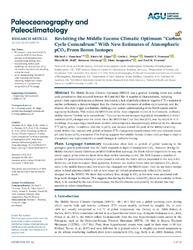Revisiting the Middle Eocene Climatic Optimum “Carbon Cycle Conundrum” With New Estimates of Atmospheric pCO2 From Boron Isotopes
Hull, Pincelli M.
Pearson, Paul N.
DOI: https://doi.org/10.1029/2019PA003713
Persistent URL: http://resolver.sub.uni-goettingen.de/purl?gldocs-11858/9248
Persistent URL: http://resolver.sub.uni-goettingen.de/purl?gldocs-11858/9248
Henehan, Michael J.; Edgar, Kirsty M.; Foster, Gavin L.; Penman, Donald E.; Hull, Pincelli M.; Greenop, Rosanna; Anagnostou, Eleni; Pearson, Paul N., 2020: Revisiting the Middle Eocene Climatic Optimum “Carbon Cycle Conundrum” With New Estimates of Atmospheric pCO2 From Boron Isotopes. In: Paleoceanography and Paleoclimatology, Band 35, 6, DOI: 10.1029/2019PA003713.
 |
Dokument öffnen: |
The Middle Eocene Climatic Optimum (MECO) was a gradual warming event and carbon cycle perturbation that occurred between 40.5 and 40.1 Ma. A number of characteristics, including greater-than-expected deep-sea carbonate dissolution, a lack of globally coherent negative δ13C excursion in marine carbonates, a duration longer than the characteristic timescale of carbon cycle recovery, and the absence of a clear trigger mechanism, challenge our current understanding of the Earth system and its regulatory feedbacks. This makes the MECO one of the most enigmatic events in the Cenozoic, dubbed a middle Eocene “carbon cycle conundrum.” Here we use boron isotopes in planktic foraminifera to better constrain pCO2 changes over the event. Over the MECO itself, we find that pCO2 rose by only 0.55–0.75 doublings, thus requiring a much more modest carbon injection than previously indicated by the alkenone δ13C-pCO2 proxy. In addition, this rise in pCO2 was focused around the peak of the 400 kyr warming trend. Before this, considerable global carbonate δ18O change was asynchronous with any coherent ocean pH (and hence pCO2) excursion. This finding suggests that middle Eocene climate (and perhaps a nascent cryosphere) was highly sensitive to small changes in radiative forcing.
Statistik:
ZugriffsstatistikSammlung:
- Geologie [930]
Schlagworte:
boron isotopespCO2 reconstruction
Middle Eocene Climatic Optimum
carbon cycle
paleoclimate
cryosphere
This is an open access article under the terms of the Creative Commons Attribution License, which permits use, distribution and reproduction in any medium, provided the original work is properly cited.

